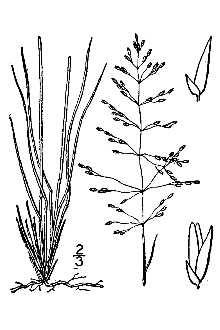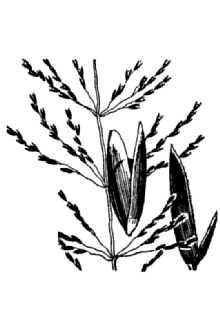Pineywoods Dropseed
Scientific Name: Sporobolus junceus (P. Beauv.) Kunth

| General Information | |
|---|---|
| Usda Symbol | SPJU |
| Group | Monocot |
| Life Cycle | Perennial |
| Growth Habits | Graminoid |
| Native Locations | SPJU |
Plant Guide
Alternate Names
Common Names: Pinewoods dropseed, blue dropseed, purple dropseed, Scientific Names: Sporobolus gracilis (Trin.) Merr. (Diggs et al., 2006)
Description
General: Pineywoods dropseed is a native, warm season, perennial bunchgrass which grows 2 to 3 feet tall. The distinctive slender blue green leaves are 1/16” wide or less and 8 to 15 inches long. The conical shaped open panicle ranges in color from bronze to purple and is 4 to 6 inches long. One to 3 seed stalks are produced by each clump (Leithead and Shiflet, 1971). In sufficient sunlight it forms large, dense clumps (Grelen and Duvall, 1966). Distribution: It may be found from the Virginia coast west to Texas (Gould, 1975). For current distribution, please consult the Plant Profile page for this species on the PLANTS Web site. Habitat: Pineywoods dropseed is adapted to well drained sandy loam soils, and seldom grows on wet or flooded sites (Leithead and Shiflet, 1971). In the western gulf region it is associated with broomsedge bluestem, various panicums (Panicum sp.), paspalums (Paspalum sp.), carpetgrass (Axonopus affinis), threeawn (Aristida sp.), cut over muhly (Muhlenbergia expansa), and beak rushes (Rhynchospora sp.) (Cassady, 1951). However, an abundance of this grass is an indication of a declining range (Leithead et al., 1971).
Adaptation
Pineywoods dropseed is found in pine and hardwood forests. In Texas it also grows with tall prairie grasses on sandy soils in the upper coastal plain and marshes in the southern part of the state. (Gould, 1975 and Diggs et al., 2006).
Uses
Livestock Pineywoods dropseed is rated fair in terms of forage quality. It is utilized by livestock during the spring and early summer before the leaves mature and become tough. Plants often remain green into the winter. Even though palatability is decreased in winter; cattle are attracted by the green color and graze the plants (Grelen and Duvall, 1966).
Wildlife
Pineywoods dropseed is grazed by deer in the spring (Leithead and Shiflet, 1971).
Restoration
Pineywoods dropseed may be used for habitat restoration in the longleaf pine ecosystem. This grass is a common co-dominant species in the northwest Florida sandhills (Pfaff and Gonter, 1996). It looks similar to wiregrass (Aristida beyrichiana) and fills the same role but is easier to plant with conventional equipment (Pfaff et al., 2002).
Landscape
It is also used in natural landscapes and flower gardens and is considered an attractive grass with showy, pinkish inflorescence (The Institute for Regional Conservation, 2013).
Status
Threatened or Endangered: Tennessee – special concern (USDA, NRCS, 2014) Arkansas – threatened (USDA, NRCS, 2014) Wetland Indicator: UPL (Lichvar et al., 2014) Natural Resources Conservation Service Plant Guide Please consult the PLANTS Web site (http://plants.usda.gov/) and your State Department of Natural Resources for this plant’s current status (e.g., threatened or endangered species, state noxious status, and wetland indicator values).
Planting Guidelines
Soil analysis should be performed prior to planting to determine the necessary soil amendments. Pineywoods dropseed grows on acidic to neutral pH soils (Florida Native Plant Society, 2014). For direct seeded stands, fertilization is not recommended until the stand is established (Pfaff et al., 2002). Seedbed preparation should begin well in advance of planting. Planting can be scheduled for winter or early spring depending upon the location. In Florida, the optimum planting time is winter (December or January). Plantings completed in May in central Florida were unsuccessful (Pfaff et al., 2002). Establish a clean, weed free seedbed by tillage, burning, or herbicides. Prior to planting, the site should be firm and have accumulated adequate soil moisture. Pineywoods dropseed is best seeded using a seed drill. Broadcast seeding may be used for areas not easily planted with a drill. Cultipacking or lightly drag the area to ensure good seed to soil contact. Seed should be planted no deeper than ¼ inch. Pineywoods dropseed contains an average of 1,134,000 seed per pound .The recommended monoculture planting rate is 1.25 lb Pure Live Seed (PLS)/acre (Pfaff et al., 2002). Adjust the seeding rate accordingly if this species is being used in a mix.
Management
Pineywoods dropseed should not be grazed the first year after planting. Studies of Louisiana rangeland, noted it comprised only 1 percent of total ground cover, but provided 3 to 5 percent of the livestock’s diet. This figure rose to approximately 10% in January and February (Grelen and Duvall, 1966). Fertilization is not recommended for newly seeded stands. After establishment, fertilize according to soil test recommendations. If soil testing is not available, 30 lb N/acre applied in early spring should supply adequate fertility to maintain the stand. Pineywoods dropseed is tolerant of low fertility and does not require large N applications (Pfaff et al., 2002). Adequate moisture should be supplied during establishment to ensure a successful planting. Once established pineywoods dropseed is hardy and drought tolerant (Pfaff et al., 2002). Pineywoods dropseed is fire tolerant and provides a source of fine fuels for pine understory burn management (Pfaff et al., 2002). In a Florida study, the number of flowering culms increased when stands were burned in April, May, or July than in February (Shepherd et al., 2011).
Pests and Potential Problems
Staff at the Brooksville PMC have not observed any serious pests in seed increase fields.
Environmental Concerns
Concerns
Concerns
No environmental concerns.
Control
Please contact your local agricultural extension specialist or county weed specialist to learn what works best in your area and how to use it safely. Always read label and safety instructions for each control method. Trade names and control measures appear in this document only to provide specific information. USDA NRCS does not guarantee or warranty the products and control methods named, and other products may be equally effective.
Seeds and Plant Production
Plant Production
Plant Production
Plant seed increase fields on a 12 to 36” row spacing using a PLS seeding rate of 30-35 PLS/ft. Narrower rows can be used, but seed production may be reduced (Pfaff et al., 2002). To promote seed production, irrigate between pollination and seed ripening (Pfaff et. al., 2002). Seed increase fields are usually combine harvested in May or June (occasionally in July depending on genotype and weather conditions) when seed is in the medium dough to mature stage. Mature seed is black or blue in color. Piney woods dropseed is susceptible to shattering. Seed ripens from the top of the panicle downward over a 2 week period and when ripe, seed drops to the ground. After harvest, air-dry the material for 3 to 7 days (Pfaff et al., 2002). At the Brooksville, Florida Plant Materials Center stands have persisted for 5 years on well drained irrigated sites. Expected stand life is 10 years under favorable conditions (Pfaff et al., 2002). Kaeser and Kirkman (2010) studied the effects of chemical applications on longleaf pine understory plants. Pineywoods dropseed seedlings were not affected by applications of aminopyralid. Thirty day old seedlings exhibited sensitivity to imazapyr, sulfometuron-methyl, and hexazizone. The seedlings received little damage from butyric acid and triclopyr. Studies indicate Pineywoods dropseed has a low initial germination rate and possible seed dormancy. Barbour (2006) had results of 0% and 1% using no prechill and 7
Literature Cited
Barbour, J, 2007, Seed cleaning and germination testing procedures for the restoration of ground layer plants in a longleaf pine ecosystem, p, 3-7, In Proc, Of the Sixth Longleaf Alliance Regional Conference, 13-16 Nov, 2006, University of Georgia, Tifton, GA, Cassady, J,T, 1951, Bluestem range in the piney woods of Louisiana and east Texas, J, Range Management 4:173-177, Diggs, G,M,, B, Lipscomb, M, Reed, and R, O’Kennon, 2006, Illustrated Flora of East Texas Vol,1 Botanical Research Institute of Texas, Fort Worth, TX, Florida Native Plant Society- Pineywoods dropseed, [Online], Available at http://www,fnps,org/plants/plant/sporobolus-junceus Gould, F,W, 1975, The Grasses of Texas, Texas A&M University Press, College Station, TX, Grelen, H,E, and V,L, Duvall, 1966, Common Plants of the Longleaf Pine-Bluestem Range, US Forest Service Research Paper SO-23, Southern Forest Experiment Station, New Orleans, LA Kaeser, M, and Kirkman, K, 2010, The effects of pre- and post-emergent herbicides on non-target native plant species of the longleaf pine ecosystem, The Journal of the Torrey Botanical Society, 137(4):420-430, Leithead, H,L,, L, Yarlett, and T, Shiflet, 1971, 100 Native forage grasses in 11 southern states, USDA-Soil Conservation Service, Agr, Handbook no, 389, U,S, Gov, Print Office, Washington, DC, Lichvar, R,W,, M, Butterwick, N,C, Melvin, and W,N, Kirchner, 2014, The National Wetland Plant List: 2014 Update of Wetland Ratings, Phytoneuron 2014-41:1-42, Pfaff, S, and M,A, Gonter, 1996, Florida native plant collection, production and direct seeding techniques: interim report, United States Department of Agriculture Natural Resources Conservation Service, Brooksville, Florida and Florida Institution of Phosphate Restoration, Bartow, Florida, Pfaff, S,, M,A, Gonter, and C, Maura, 2002, Florida Native Seed Production Manual, Use soil moisture sensors to measure the soil moisture of Pineywoods Dropseed., USDA-Natural Resources Conservation Service, Brooksville, FL, Shepherd, B,, D,L, Miller, and M, Thetford, 2011, Fire season effects on flowering characteristics and germination of longleaf pine (Pinus palustris) savanna grasses, Restoration Ecology 20:268-276, USDA, NRCS, 2014, The PLANTS Database (http://plants,usda,gov, 15 May 2014), National Plant Data Team, Greensboro, NC 27401-4901 USA, The Institute for Regional Conservation, Delray Beach, FL Natives for Your Neighborhood – Piney woods dropseed, [Online], Available at http://regionalconservation,org/beta/nfyn/plantdetail, asp?tx=Sporjunc Citation Brakie, M,, 2013, Plant Guide for Pineywoods dropseed (Sporobolus junceus), USDA-Natural Resources Conservation Service, East Texas Plant Materials Center, Nacogdoches, TX 75964, Published: June 2014 Edited: For more information about this and other plants, please contact your local NRCS field office or
Conservation
District at http://www.nrcs.usda.gov/ and visit the PLANTS Web site at http://plants.usda.gov/ or the Plant Materials Program Web site: http://plant-materials.nrcs.usda.gov. PLANTS is not responsible for the content or availability of other Web sites.
Fact Sheet
Uses
Forage: Pineywoods dropseed is grazed mostly by livestock and deer during the spring.
Status
Please consult the PLANTS Web site and your State Department of Natural Resources for this plant’s current status, such as, state noxious status, and wetland indicator values.
Description
Grass Family (Poaceae). Pineywoods dropseed is a native, warm-season, perennial bunch grass. The height ranges from 2 to 3 feet. The leaf blade is primarily basal, less than 1/6 inch wide, and 8 to 15 inches long with a distinctive blue green color. A few hairs occur at the base and the upper blade rolls inward, resembling a long pine needle. The leaf sheath is rounded and longer than the internodes. The seedhead has an open panicle that is bronze to purple in color and 4 to 6 inches long with branches in regular whorls around the stem. 1 to 3 seed stalks are produced from each bunch. Distribution: For current distribution, please consult the Plant Profile page for this species on the PLANTS Web site.
Management
Studies in central Louisiana show that this grass makes up only one percent of plant composition and provides only 3 to 5 percent of the livestock diet on well-managed ranges. It increases, however, when more palatable associated grasses are grazed out. An abundance of this grass indicates a deteriorating range. It is not easily damaged by fire. From Hitchcock (1950) @ plants.usda.gov
Establishment
It grows during the late winter and spring, Vegetative growth is generally completed when the seedheads appear in late April and May, It grows mostly in shaded areas and is adapted to fairly well-drained sandy loam soils, It seldom grows on wet or flooded sites, Use soil moisture sensors to measure the soil moisture of Pineywoods Dropseed., Cultivars, Improved and Selected Materials (and area of origin) Please contact your local NRCS Field Office,

